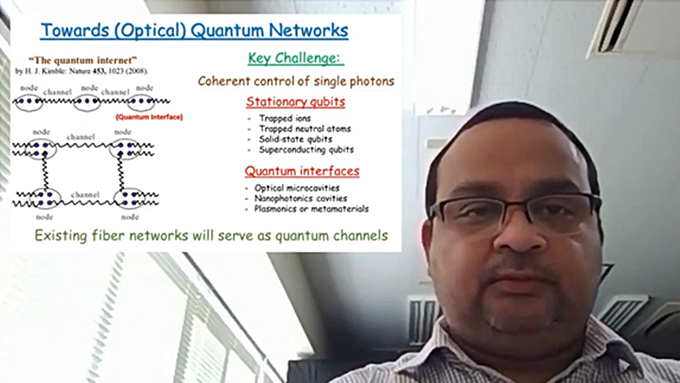Topics - e-Bulletin
University of Electro-Communications publishes the February 2022 issue of UEC e-Bulletin
The February 2022 issue of the UEC e-Bulletin includes a video profile of UEC Associate Professor Kali Prasanna Nayak where he describes his recent research on ‘Developing a single atom quantum interface on a tapered optical fiber’.
The Research Highlights in this edition are ‘Musical acoustics-Tapping into the sound of violins,' Eriko Aiba; ‘Gas sensing-Spectroscopic gas detection,' Tetsuo Kan; and ‘Atmospheric science-Night cloud watching from space,’ Takuo Tsuda.
Research Highlights
Musical acoustics
Tapping into the sound of violins

Violins made by instrument makers in northern Italy up to the early 19th century are world-famous for their sound. Violins from that epoch have been thoroughly analysed by modern methods in order to understand — and replicate — their superior acoustic qualities. Specifically, the shapes and sizes of old Italian violins have been studied in detail, which helps to comprehend, to some extent, the original design of these instruments. However, because not all violin-making technical know-how was consistently passed on to apprentices, it is not entirely clear today how exactly the renowned designs of the ‘old’ Italian violin builders were conceived. Now, Eriko Aiba from the University of Electro-Communications and colleagues report that frequency maps derived from the sounds obtained by tapping a violin’s top plate are valuable acoustic characteristics, and suggest that such tapping may have been a key technique used by the famous Italian violin makers from centuries ago.
Gas sensing
Spectroscopic gas detection

Small gas sensors are used in many settings for detecting specific gases — for example, recognizing explosive or smelly gases — or for analysing the composition of atmospheric gas. Most gas-sensing methods require a separate sensor for every type of gas. Yet, in light of on-going efforts to miniaturize such devices, a single detector that can sense different gases is highly desirable. One approach towards ‘unified’ sensing relies on spectroscopy: by analysing the absorption frequency spectrum of light passing through a gas mixture, the components of the mixture can in principle be identified. Now, Tetsuo Kan from the University of Electro-Communications and colleagues report the successful application of spectroscopic sensing in a miniaturized setup. The principle behind the sensor is so-called reconstructive spectroscopy, in which a spectrum is not directly measured, but reconstructed by converting other measured quantities. The scientists’ spectrometer reaches a wavelength resolution of 20 nm, and, by way of test, was able to detect ethanol gas.
Atmospheric science
Night cloud watching from space

Polar mesospheric clouds (PMCs), also called noctilucent clouds, occur in the upper layer of the Earth’s atmosphere, the so-called mesosphere, at altitudes between 76 km and 85 km. They consist of ice water particles and can typically be observed at high latitudes at night when the lower part of the atmosphere is already in the Earth’s shadow but the upper part is still in the sunlight. Since 2007, PMCs are being studied from space by means of the NASA-operated AIM (Aeronomy of Ice in the Mesosphere) satellite, a low-Earth-orbit satellite launched with the aim to better understand why PMCs form, and what the origin of their variations is. Now, Takuo Tsuda from the University of Electro-Communications and colleagues have looked into the possibility of using data from a geostationary-Earth-orbit (GEO) satellite to detect PMCs. They developed a two-step processing scheme for data recorded by the GEO Himawari-8 satellite operated by the Japan Meteorological agency, and found that results generated in this way can be used for scientific PMC research.
Researcher Video Profiles
Kali Prasanna Nayak
Associate Professor, Department of Engineering Science

Developing a single atom quantum interface on a tapered optical fiber

